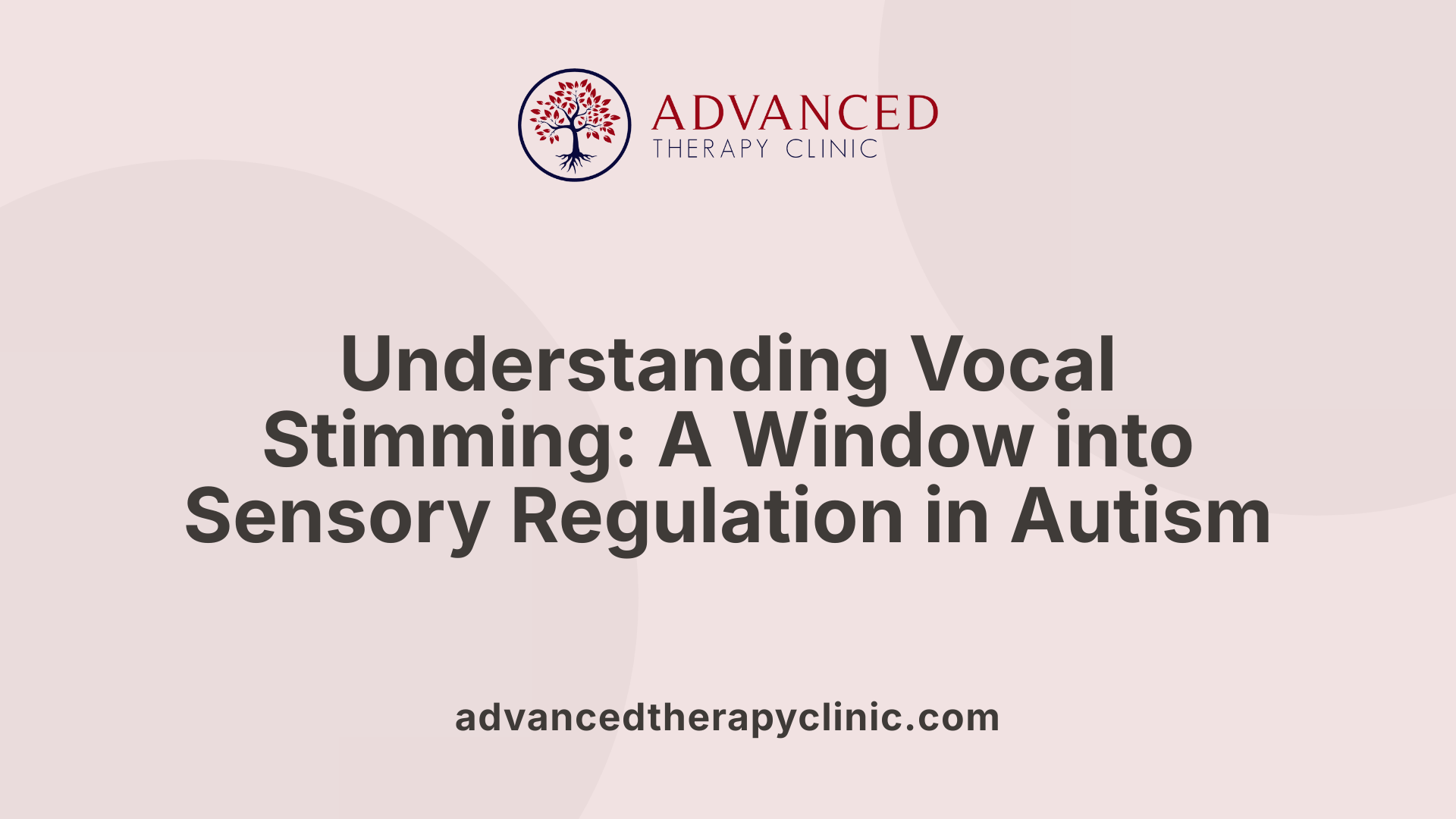Vocal Stimming In Autism


What Is Vocal Stimming and Why Does It Matter?
Vocal stimming, a subset of self-stimulatory behaviors, is a common characteristic among individuals on the autism spectrum. Often misunderstood, vocal stimming serves as both a coping mechanism and a source of enjoyment, providing sensory input that can help regulate emotions such as excitement, anxiety, and stress. This article explores the nature of vocal stimming, its role in autism, and how it intersects with therapeutic approaches designed to support autistic individuals in their daily lives.
Defining Vocal Stimming and Its Role in Autism

What is vocal stimming?
Vocal stimming is a type of self-stimulatory behavior seen in individuals on the autism spectrum. It involves repetitive vocal sounds such as humming, making noises, finger-snapping, or repeating words. These vocalizations provide sensory input that helps regulate the individual's internal state.
Types of stimming with focus on vocal/auditory modalities
Stimming behaviors are categorized by sensory modality. Vocal stimming falls under the auditory category, which includes actions like humming, finger-snapping, and other repetitive sounds. These behaviors differ from tactile (e.g., skin rubbing), visual (e.g., staring), or vestibular (e.g., rocking) stims.
Why do autistic individuals engage in vocal stimming?
Vocal stimming serves multiple purposes. It can be a coping mechanism to manage emotional states such as excitement, boredom, stress, fear, and anxiety. Additionally, it can simply be a source of enjoyment or self-soothing. For example, an autistic person might hum to calm themselves during a stressful event or snap fingers when feeling bored.
Understanding vocal stimming provides insight into how autistic individuals interact with their environment and emotions, highlighting the importance of supportive approaches that respect these behaviors as meaningful forms of sensory regulation and expression.
Sensory Modalities and Vocal Stimming Within Stimming Spectrum

What types of stimming are there?
Stimming behaviors are classified based on the sensory senses they engage. The main categories include:
- Auditory: Involving sounds such as humming, finger-snapping, or repetitive vocalizations.
- Tactile: Actions like rubbing skin or repetitive fist movements.
- Visual: Behaviors such as staring, blinking lights, or lining up objects.
- Vestibular: Movements involving balance, like rocking, spinning, or pacing.
- Olfactory/Taste: Activities including sniffing, licking, or tasting objects.
Auditory forms of stimming such as humming and finger-snapping
Auditory stimming often involves producing repetitive sounds which can be soothing or help regulate sensory input. For example, humming is a common auditory stim that may comfort or help focus the individual. Finger-snapping is another auditory stim that provides rhythmic sensory feedback. These forms of stimming engage hearing and help modulate emotional states such as excitement or anxiety.
How vocal stimming fits into broader sensory experiences
Vocal stimming, a subset of auditory stimming, includes repetitive mouth sounds, humming, or making noises. These vocalizations serve as a self-regulation technique, providing sensory input to the auditory system. By producing consistent rhythms or tones, vocal stimming helps manage emotions and offers a controllable sensory experience within the broader stimming behaviors that span multiple senses.
| Sensory Modality | Example Behaviors | Description |
|---|---|---|
| Auditory | Humming, finger-snapping | Producing repetitive sounds for sensory input |
| Tactile | Skin rubbing, fist moves | Engaging touch receptors through repeated motion |
| Visual | Staring, blinking lights | Using visual stimuli in a repetitive manner |
| Vestibular | Rocking, spinning, pacing | Movement-based stimming impacting balance senses |
| Olfactory/Taste | Sniffing, licking | Involving smell and taste sensory exploration |
This breakdown helps understand where vocal stimming fits in the sensory landscape of autistic self-stimulatory behaviors.
The Benefits and Challenges of Vocal Stimming

How vocal stimming acts as a coping mechanism
Vocal stimming, such as humming or finger-snapping, is a common self-stimulatory behavior in autistic individuals. It often helps them cope with overwhelming emotions like excitement, stress, anxiety, or boredom. By engaging in repetitive sounds, individuals can regulate their sensory input and emotional state, providing comfort and predictability during challenging moments.
Positive aspects of vocal stimming
Beyond coping, vocal stimming can be a source of enjoyment and self-expression. It supports emotional self-regulation and can help improve focus by blocking out distracting stimuli. Such behaviors often increase feelings of calmness and reduce distress, which can enhance overall well-being and daily functioning.
Potential negative impacts such as social difficulties or physical concerns
While vocal stimming is generally harmless, it can sometimes lead to social challenges. Repetitive vocalizations may draw unwanted attention or misunderstandings from others, potentially causing social isolation or discomfort. In rare cases, persistent vocal stimming may strain the vocal cords or affect communication. When these impacts become significant, behavior management therapies like Applied Behavior Analysis (ABA) can assist in reducing or modifying these behaviors.
Is vocal stimming always harmful?
No, vocal stimming is typically benign and serves important emotional and sensory functions for autistic individuals. However, if it causes social difficulties, physical harm, or distress, professional support through behavioral interventions or therapy might be beneficial to help manage these effects.
Behavioral Therapies Addressing Vocal Stimming in Autism

How can therapy help with managing vocal stimming?
Behavioral therapies such as Applied Behavior Analysis (ABA) play a significant role in managing vocal stimming when it interferes with daily life or causes distress. ABA works by reinforcing positive behaviors and systematically reducing challenging or harmful behaviors. This approach involves breaking skills into small, achievable steps and using techniques like positive reinforcement and behavior analysis tailored to each individual's needs, skills, and family environment.
ABA focuses on improving communication, social engagement, and self-care, while also respecting the individual's sensory needs. Importantly, therapy aims not to suppress necessary sensory input but to modify stimming behaviors that may be physically harmful or socially limiting. This individualized and evidence-based approach supports autistic individuals to function more comfortably in different environments.
Why is early intervention crucial in autism treatment?
Starting behavioral therapies early greatly enhances outcomes for children on the autism spectrum. Early intervention—using programs incorporating ABA principles, like the Early Start Denver Model (ESDM)—helps develop communication and social skills before patterns become entrenched.
Early behavioral therapy can reduce the intensity or frequency of disruptive stimming by teaching alternative ways to self-regulate emotions like anxiety or excitement. This foundation supports learning and engagement, fostering skill development during critical stages of brain growth.
How do behavioral therapies modify stimming behaviors without suppressing needed sensory input?
Behavioral therapies recognize that stimming may serve as a coping mechanism or sensory regulation tool. Instead of eliminating all repetitive behaviors, therapies aim to identify when stimming is interfering with safety or learning.
For example, vocal stimming such as humming or repetitive noises may be redirected towards more socially acceptable forms or managed so it occurs in appropriate contexts. Therapies teach skills that help individuals express needs and manage emotions constructively while ensuring that sensory needs are met in safe, supportive ways.
This balance allows autistic individuals to maintain sensory comfort without facing undue harm or social isolation. Ultimately, behavioral interventions promote independence and emotional well-being while respecting neurological differences.
Applied Behavior Analysis (ABA): A Flexible Approach to Vocal Stimming

What is ABA and how does it help with vocal stimming?
Applied Behavior Analysis (ABA) is a therapy grounded in the science of learning and behavior. It aims to increase positive, helpful behaviors while reducing harmful or disruptive ones, making it highly effective for managing behaviors like vocal stimming in individuals with autism.
ABA does this through careful observation and analysis of behavior patterns and their environmental triggers. Techniques such as positive reinforcement encourage the repetition of desirable behaviors, while strategies break down complex skills into achievable steps.
Principles and goals of ABA
The primary objectives of ABA include improving communication, social skills, and daily functioning. For vocal stimming, ABA focuses on understanding when and why the behavior occurs, then teaching alternative or more appropriate behaviors to meet the same needs or emotional states.
How ABA targets helpful behaviors and reduces harmful ones
ABA therapists use methods like antecedent-behavior-consequence analysis to identify causes and rewards of vocal stimming. By modifying these factors, ABA helps reduce disruptive stimming while reinforcing communication skills, improving social interactions, and lessening anxiety.
Tailoring ABA to individual needs including vocal stimming management
ABA is highly individualized. Licensed behavior analysts design programs based on the unique needs, abilities, and circumstances of each person. This customization ensures that interventions for vocal stimming align with the individual's interests and comfort.
Programs also respect the sensory and emotional needs of the individual, incorporating relaxing activities and emotional support rather than forcing suppression of natural behaviors. This balanced approach helps improve overall wellbeing while promoting effective communication and social engagement.
Speech and Language Therapy’s Role in Addressing Vocal Stimming
How does speech therapy help with vocal stimming?
Speech and language therapy plays a crucial role in supporting autistic individuals who engage in vocal stimming, such as humming or repetitive sounds. This therapy focuses on improving both verbal and non-verbal communication skills, helping individuals develop more purposeful ways to express their needs, emotions, and thoughts. By enhancing communication abilities, speech therapy can provide alternatives to vocal stimming, thereby reducing its frequency when it becomes disruptive.
Speech therapy techniques for communication development
Speech therapists employ a variety of techniques tailored to the individual's abilities and needs. These include:
- Speech articulation exercises: Target the clarity of sounds to improve overall speech intelligibility.
- Vocabulary development: Expand the individual's word knowledge to aid in more precise expression.
- Social communication skills: Teach appropriate conversational skills and cues to enhance interactive communication.
- Augmentative and Alternative Communication (AAC) systems: Utilize tools such as picture boards, speech-generating devices, or apps to support communication for those with limited verbal skills.
How speech therapy intersects with vocal stimming
Many vocal stims occur when individuals seek sensory input or have difficulty communicating. Speech therapy addresses this by helping individuals identify their communication needs and find effective ways to meet them, reducing the reliance on repetitive vocal behaviors. For example, a child who hums when anxious may learn to use words or AAC devices to express feelings instead.
Use of augmentative communication to support those affected
When verbal communication is limited, augmentative communication offers practical support. AAC systems provide alternative methods to express oneself, which can decrease frustration and the need for vocal stimming. Customized AAC tools are integrated into speech therapy programs to enhance interaction and social engagement, fostering greater independence.
Through these approaches, speech and language therapy offers meaningful support that respects the individual's unique stimming behaviors while promoting improved communication and quality of life.
Supporting Autistic Individuals’ Needs While Respecting Stimming
Balancing therapy goals with the need to stim
Therapies such as Applied Behavior Analysis (ABA) aim to reduce harmful or disruptive behaviors while recognizing that stimming often serves important sensory and emotional functions for autistic individuals. The goal is to enhance skills and independence without eliminating stimming that provides comfort or joy.
Avoiding suppression or masking of stimming behaviors
Therapists are advised not to discourage all vocal or physical stimming, as forcing suppression can increase anxiety and lead to masking—where autistic people hide their natural behaviors to fit in socially. Instead, therapy focuses on minimizing stimming only when it causes harm or interferes significantly with daily life.
Incorporating relaxing activities and emotional support
Effective autism therapy programs include opportunities for relaxation and activities tailored to sensory preferences. Providing emotional support helps individuals feel safe and reduces stress-related stimming. Such balanced approaches promote well-being while respecting sensory needs.
Should therapy discourage all vocal stimming?
No, therapies should respect the autistic individual's need to stim comfortably and avoid encouraging masking or neurotypical conformity. Instead, they focus on reducing harmful stimming, supporting sensory needs through relaxation and emotional care.
| Aspect | Approach | Purpose |
|---|---|---|
| Therapy goal balance | Reduce harmful behaviors; respect comfort | Promote positive development without unnecessary suppression |
| Vocal stimming | Allowed unless harmful | Preserve sensory self-regulation |
| Relaxing activities | Included in programs | Support emotional well-being and reduce stress-driven stimming |
| Emotional support | Integral part of therapy | Enhance feelings of safety and acceptance |
Medication and Other Supports for Vocal Stimming
When medications might be prescribed
Medication may be considered when vocal stimming leads to significant distress or results in physical harm. While stimming behaviors are often part of an autistic individual's way of coping or self-expression, some cases require additional intervention to ensure safety and well-being.
Types of medications used
Commonly prescribed medications include Selective Serotonin Reuptake Inhibitors (SSRIs), antipsychotics, and anti-anxiety drugs. SSRIs can help manage symptoms of anxiety or obsessive behaviors that might underlie some stimming actions. Antipsychotics may be used in situations where stimming is severe or linked with behavioral challenges. Anti-anxiety medications work to reduce stress and tension that can trigger repetitive vocalizations.
Role of nutritional therapy and technology in support
Beyond medications, nutritional therapy can play a valuable role by addressing dietary sensitivities and supporting gut health, which contributes to overall well-being. Additionally, modern technology, such as interactive apps and virtual reality programs, is increasingly incorporated into autism education and therapy. These tools enhance engagement and skill development, providing alternative pathways to support communication and reduce maladaptive stimming.
| Support Type | Purpose | Examples |
|---|---|---|
| Medication | Reduce distress and physical harm | SSRIs, antipsychotics, anti-anxiety |
| Nutritional therapy | Improve gut health and overall well-being | Dietary plans, supplements |
| Technology | Enhance engagement and learning | Interactive apps, virtual reality |
Accessing and Maximizing Vocal Stimming Support Services
How can families access therapy for vocal stimming?
Families aiming to support vocal stimming behaviors in autism can pursue several practical avenues. Initially, consulting with medical providers enables a proper diagnosis and therapy referral, often essential for insurance purposes.
Insurance coverage is a critical factor in therapy access. Many insurance plans cover Applied Behavior Analysis (ABA) therapy when prescribed by a doctor and deemed medically necessary, though specifics depend on location and policy. ABA, known for its effectiveness in managing and supporting stimming behaviors, requires engagement with certified specialists.
Qualified professionals, such as Board Certified Behavior Analysts (BCBAs), design and oversee personalized ABA programs. These experts tailor therapy to individual needs, including vocal stimming, ensuring interventions are both sensitive and effective.
Parental involvement and training play a vital role. Families who learn ABA techniques can consistently reinforce positive communication patterns and manage stimming within everyday environments, enhancing treatment outcomes.
To locate providers, families can utilize resources like local autism support organizations, online directories, and recommendations from healthcare providers. These options help connect families with experienced therapists skilled in addressing vocal stimming and related behaviors.
Together, these steps enable families to access comprehensive vocal stimming support, maximizing therapy benefits through professional and personal collaboration.
Recognizing and Respecting Vocal Stimming in Autism
Vocal stimming is a deeply personal and essential part of the autistic sensory experience, providing comfort, expression, and regulation. Understanding its purpose allows caregivers, therapists, and society to support these behaviors thoughtfully—balancing the need to reduce harmful effects with the respect for sensory needs and individuality. Through early, evidence-based interventions like ABA and speech therapy coupled with compassionate approaches, autistic individuals can thrive, enhancing communication and social engagement while retaining their unique ways of connecting with the world.
References
Recent articles

Expressive Speech Delay 2-Year-Old
Understanding and Addressing Expressive Speech Delay in Toddlers

How Speech Recognition Works
Unlocking the Power of Speech Recognition in Therapy and Healthcare

Autism and Head Size
Understanding the Complex Relationship Between Autism and Head Size

Occupational Therapy in Autism
Enhancing Independence and Quality of Life Through Occupational Therapy in Autism

Do Autistic People Understand Sarcasm?
Navigating the Nuances: Understanding Sarcasm and Social Communication in Autism

Autism Routines
Crafting Effective Daily Structures for Children with Autism


